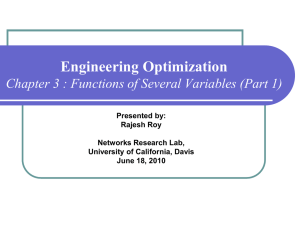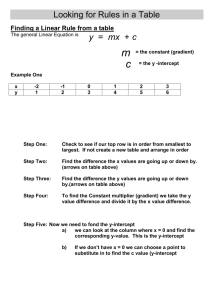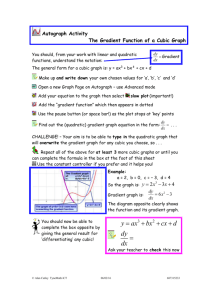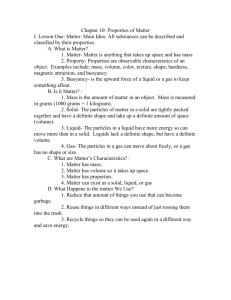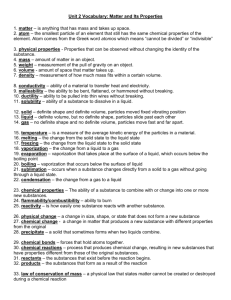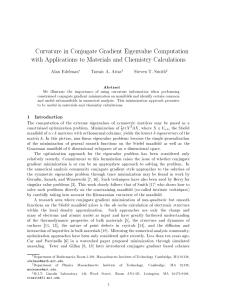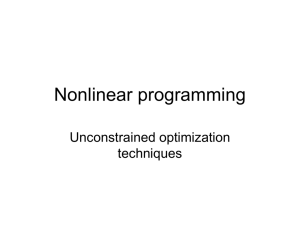optimization
advertisement
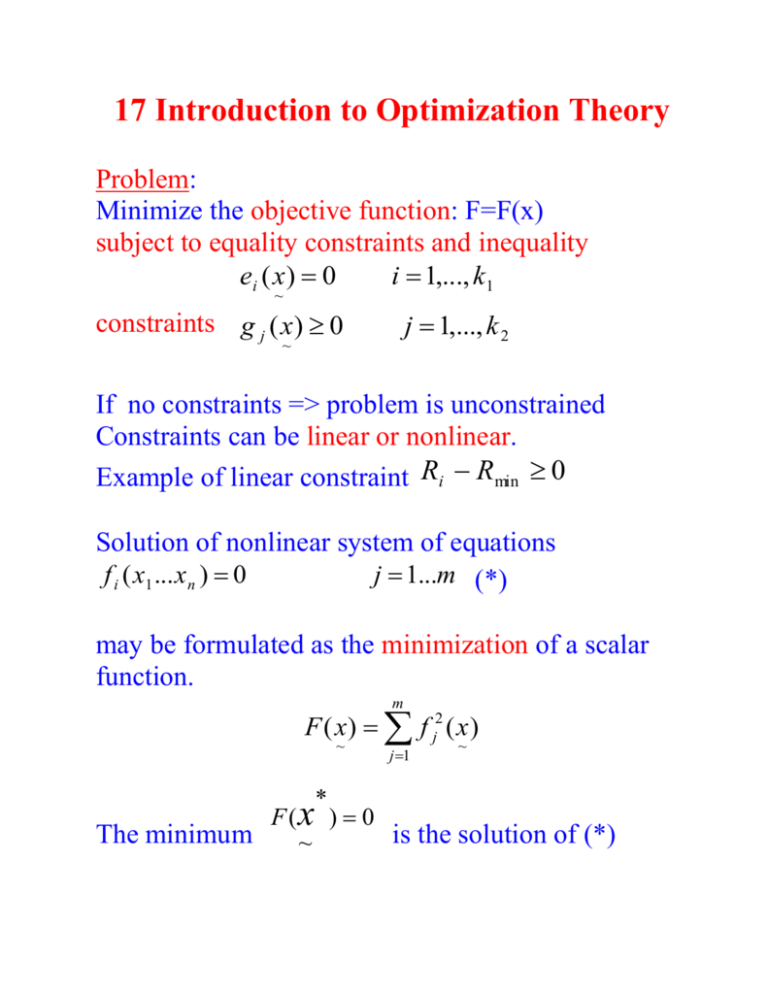
17 Introduction to Optimization Theory Problem: Minimize the objective function: F=F(x) subject to equality constraints and inequality ei ( x ) 0 i 1,..., k1 ~ constraints g j ( x ) 0 j 1,..., k 2 ~ If no constraints => problem is unconstrained Constraints can be linear or nonlinear. Example of linear constraint Ri Rmin 0 Solution of nonlinear system of equations f i ( x1 ... x n ) 0 j 1...m (*) may be formulated as the minimization of a scalar function. m F ( x ) f j2 ( x ) ~ * j 1 ~ F(x ) 0 The minimum is the solution of (*) ~ Most modern minimization techniques are based on K determining sequence of vectors X~ such that F ( x 0 ) F ( x 1 )... F ( x k ) ~ ~ ~ Define gradient (points the direction of increasing f) F F F ( x) ~ ~ ~ x1 F F ... x 2 x n F Condition for minimum ~ T x 0 ~ ~ Lagrange multipliers method for constrained minimization: minimize: F ( x~ ) 0 e j ( x) 0 subject to: ~ j = 1,2,. . . , k Form the Lagrangian function k1 Lx 1 f ( x ) j e j ( x ) j1 where 1 ,..., k1 T is a vector of Lagrangian multipliers (extra variables). To find the optimum of the constrained problem the derivatives of L x , are set to zero ~ The ~ e j L F k1 0 j xi j 1 xi x L 0 i ~ ~ L e j x 0 j ~ * * solution is a pair x ~ i 1...n j 1... k ~ 17.3 Basic Iterative Algorithm 0 Given F x~ and an initial point x~ . We want to proceed from x0 to other points such that F x F x F x 0 1 ~ k ~ ~ Determine a search direction in a n-dimensional space s s s k ~ k 1 k T n and take a step of length dk along this direction. Now we have x ~ k 1 x dk s k ~ ~ k In the efficient algorithm search directions must be linearly independent, so the matrix S s s s ~ 0 ~ 1 ~ ~ n 1 is nonsingular Search along a line is used to determine the step length dk using quadratic or cubic interpolation. 17.5 Quadratic Functions in Several Variables Expand F x~ into a Taylor series truncated after the third term. x x T F 1 x T G x x F x x F (*) ~ ~ 2 ~ ~ ~ ~ ~ where ~ F is gradient and 2F x1x1 G x 2 ~ ~ F x x n 1 is the Hessian matrix 2F x1x 2 2F x1xn 2 F xn x n k If we minimize F x~ in a given direction s~ then at the minimum in this direction x~ must be orthogonal to s~ s kT ~ (search direction) S k k 1 the gradient ~ F so F k 1 0 ~ K ~ k 1 F k 1 X min (gradient) X K ~ ^ at point x such that F xˆ 0 ~ We have from (*) and x Gxˆ x T ~ ~ ~ ~ F x x F ~ ~ T 1 x x G xˆ x ~ 2 ~ ~ determines type of the solution x~ . If G is ~ positive definite s G s 0 minimum T ~ ~ ~ negative definite s G s 0 max imum T ~ ~ ~ indefinite s G s 0 and 0 saddle po int T ~ ~ ~ Example 17.5.1 F x x 2 x1 1 x1 2 2 ~ ( x ) is positive definite at Show that Hessian G ~ x̂ = [1 1] 2 F x x G x 1 1 ~ ~ 2F x 2 x 1 2F x 1x 2 4 2 2 2 2 F x 2 x 2 G x is positive definite since all leading principal ~ ~ minors are positive.For N N positive definitive i j matrix G~ we define s~ & s~ vectors to be G~ conjugate s G s k0 0 ii jj i T ~ j ~ ~ i (*) i s vectors satisfying (*) are also linearly ~ independent. Example 17.5.2 Use the Hessian matrix from the previous example and find a) the conjugate direction to s0=[1 0]T b) the conjugate direction to s0=[1 -1]T To solve a), form 4 2 1 4 Gs 0 2 2 2 0 define s1 as s1=[a1 a2]T, we require [a1 a2][4 -2]T=0 or a2=2 a1 so, selection of s1=[1 2]T provides the solution. Similar in case b) we will get s1=[2 3]T The minimum of a quadratic positive definite function is reached in at most n iterations (n is the number of variables). Further properties established for the general quadratic function 1 T x Gx ~ ~ ~ 2~ ~ ~ with positive definite matrix G~ . F x a b x T F b G x The gradient is ~ ~ ~ ~ Consider gradient at 2 subsequent steps: k k 1 F k b G x and F k 1 b G x ~ ~ ~ ~ ~ Their difference is F k 1 F k G x k ~ ~ but x~ k 1 ~ ~ ~ ~ ~ k 1 ~ x k ~ x x d k s k (search direction times step ~ ~ k k G x dk G s k size) so F ~ k 1 k ~ ~ k ~ ~ F k dk G s k and ~ ~ ~ where the step size dk is selected to reach the minimum in a given search direction. Multiply both sides by a G conjugated vector s k 1 to get s k 1 F k 1 s k 1 F k d k s k 1 G s k 0 ~ ~ ~ Repeating this for different k=1,…,n we can establish that at after n steps Fn 0 ~ which concludes that the minimum of a quadratic positive definite function is found in at most n iterations. 17.6 Descent Methods for Minimization The problem is how to find the search direction s~ k A. Steepest Descent Method s k F k has a tendency to oscillate B. Conjugate Gradient Method. s 0 F 0 s1 F 1 K11s 0 . . k s F K ik s i1 , 1 k n 1 k k i 1 where (assuming that the minimum in previous search direction was reached) we can show that F F F F i T K ii i 1 T i i 1 C. The Newton Method (based on 2nd derivatives) Function F(x) is expanded into a Taylor series and truncated to quadratic terms only 1 T k k k T k F x x F x x F x G x x ... ~ ~ 2 ~ ~ ~ ~ ~ We want to minimize the lhs, so we differentiate this equation wrt x~ and set the derivative to zero to get F k G k x x 0 or ~ ~ ~ G k x x F k ~ ~ ~ so the search direction is F s x G k k ~ k 1 k ~ H k F k with Hessian matrix positive definite a full step in the search direction can be taken D. Variable Metric Methods This methods are more sophisticated. k 1. Calculate ~ F and find the search direction s H Fk k ~ k ~ where the matrix H 1 0 ~ ~ ~ H ~ k is positive definite - initially k Only when the minimum is reached H~ simulates the Hessian or its inverse (and then the variable metric method looks like the Newton method). 2. Find the minimum in the search direction sk , determining dk and then calculate k F k 1 F k G x k ~ ~ ~ ~ k 3. Update matrix H ~ using a formula H ~ k 1 k k k , x , F , k , H ~ ~ ~ where H k 1 F T H x xT , , H, x, H 1 ~ ~ ~ ~ ~ T T ~ ~ ~ ~ x x ~ ~ ~ ~ 1 T H H k H ~ ~ ~ ~ xT ~ ~ ~ ~ x T H H x T ~ ~ ~ ~ ~ ~ T T 0 , are selected scalars and x~ 0, H ~ ~ ~ ~ k 0 H Note that if ~ symmetrical H symmetrical ~ Many updating formulae have been used, which can be derived from expression on F, e.g. 1. If k 1 and k 0 then x x H H T T ~ ~ F 1, 0, H , x, H ~ T ~ T~ ~ ~ ~ ~ ~ x H ~ ~ ~ ~ ~ This formula was derived by Davidson, Fletcher and Powell and is called DFP formula. 2. If k 1 and k 1 then T H x xT 1 ~ T T F 1,1, H , x, H 1 ~ T ~ ~ T ~ T x H x ~ ~ ~ ~ ~ ~ ~ x x x ~ ~ ~ ~ ~ ~ ~` This formula was developed by Broyden, Flethcer, Goldfarb and Shanno and is called BFGS formula. 17.7 Constrained Minimization x F F Minimize ~ x0 e i subject to ~ i = 1, . . . , k1 Is solved using Lagrangian: T T L x, F x i e i x Fx e x F x e x ~ ~ ~ ~ ~ ~ ~ ~` ~ ~ ~ i where ~ 1 ... k1 w.r.t. x~ and ~ and set e e1 ... e k1 T Differentiate L x~ , ~ derivatives to zero: ~ T L FN x 0 x ~ ~ ~ ~ ~ ~ L 0 L ~ ~ e x 0 ~ ~ ~ ~ (*) where N e1 e2 ... ek1 ~ ~ ~ ~ e1 e2 ek1 .. x x x 1 1 1 e ek1 1 x n x n We solve (*) using Newton-Raphson iteration. Jacobian matrix equals 2L L L x x ~ ~2 ~ M ~ ~ L x ~ ~ x~ ~ M1 N ~ ~ T 0 N ~ ~ 2L x ~ ~ 2 L ~ ~ where K1 2 ei 2F m jl i x j x L I 1 x j x L m jl M 1 and the Newton-Raphon iteration is formulated as xk F k N k k k ~ M ~ k Lk ~ k ~ ~ e ~ ~ The first equation can be reduced since if k k 1 k we have k k k 1 k k k M x N F k N ~ ~ x and N ~ ~ ~ k T ~ ~ k e ~ ~ ~ k ~ so the iterations can be obtained from Mk ~1 N k ~ k N x k F k ~ k~1 ~ k 0 ~ e~ ~ Example In symbolic value detection problem we need to solve the following equation to find Hs1 and Hs2 vectors: c ~s 1 R11R2 ~s 2 pinv C~s 1 C1 (**) Since ~s 1 and ~s 2 cannot be uniquely defined, one can either set ~s 2 to zero and H ~ H or introduce s1 c another constraint for elements of ~s 1 and ~s 2 , for instance minimize the norm of H under constraint defined by (**). The constraint minimization problem can be formulated using a Lagrangian function with the objective: F h~s2i h~s i ~s with constraints e ~s 1 R11 R2 ~s 2 pinv C~s 1 C1 0 The Lagrangian function is defined as follows: c LH ~s , F j e j ej e j 1 where c is the cardinality of Hc In order to locate the optimum of the constrained minimization of || ~s || the derivatives of L ~s , with respect to H and are set to zero L F N 0 h~s i L e j H ~s 0 where e1 h~s 1 F 2 ... h~s n ... e D c and , n = s 1 where D R1 R2 After determining derivatives of L( ~s ,), we will obtain ~s 1 2 0 ~s 2 D which can be split into two equations 2 ~s 1 0 and 2 ~s 2 D 0 2 ~ D ~s 1 ~ then s 1 and s 2 After substituting results to (**) a new equation is obtained as follows: ~s 1 DD ~s 1 pinv C~s 1 C1 0 From which a unique solution for ~s 1 can be obtained ~s 1 1 DD pinv C~s 1 C1 Thus, the minimum norm solution of (**) is ~s 1 s D ~s 1 1

